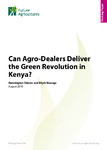Can Agro-Dealers Deliver the Green Revolution in Kenya?
Abstract
The Government of Kenya, with the backing of development and charitable organisations, has been implementing programmes to increase agricultural productivity
and rural incomes and trigger a new Green Revolution
(GR). These activities focus on increasing farmers’ access
to and application of modern farming inputs, particularly
improved seeds and fertilisers, delivered mainly through
agro-dealers. Given that Kenyan farmers operate in a
highly heterogeneous environment, this study was motivated to ask: Can agro-dealers deliver the Green
Revolution in Kenya? In answering this question, the
study examined the evolution and characteristics of agrodealers in the cereals subsector and explored how they
command a central position in policy narratives put
forward by key actors in the policy arena, each advocating
a new GR for Kenya.
Several key findings emanate from this study. First,
both formal and informal seed systems are important
channels for delivering cereal seeds to Kenyan farmers.
The informal systems (which do not involve agro-dealers)
provide seeds of local maize and other cereals to farmers
in low rainfall areas in the greater Eastern region of the
country. Conversely, the formal systems use agro-dealers
in providing mainly improved maize seed to farmers in
high rainfall areas of the greater Western and Central
regions of the country. Notwithstanding the importance
of the informal systems to many smallholder farmers,
the legal, regulatory and policy frameworks, which are
informed by international seed policies and conventions,
tend to favour the formal systems. As a result, agrodealers may only spur a GR for a select group of privileged
producers, mainly maize farmers operating in higher
rainfall areas.
Second, while actors in the seed industry employ
different approaches in their activities, they are driven
by narratives put forward by particular key actors, all
converging on the notion of the ‘agro-dealer’ as the
carrier of improved seeds to farmers. Interestingly, while
the actors promote the agro-dealer agenda, due to
different politics and interests, they also support parallel
activities that seem to undermine development and
expansion of the agro-dealer network in some places.
Third, Kenyan agro-dealers engage in the sale and
promotion of diverse commodities as a risk coping
mechanism for business survival. Therefore, initiatives
aimed at supporting agro-dealers ought to focus on the
totality of the business instead of only seeds and
fertilisers. As well, if agro-dealers are to deliver a GR in
Kenya, capacity training programmes for agro-dealers
should not only target the business owners but also
‘managers’ (i.e., those who actually serve customers and
are responsible for dispensing advice and information
as well as products).
Fourth, the universalising of agro-dealer narrative in
GR programmes overlooks the heterogeneity of the ‘poor
smallholder farmers’ and agro-dealers themselves. This
has resulted in biased beneficiary targeting and disproportionate ‘wins’ for farmers and agro-dealers in high
rainfall areas and large agro-dealers in low rainfall areas.
Therefore, greater attention must be paid to meeting
the needs of farmers in lower potential areas by developing innovative alternative business models. Such
models might include sale of complementary non-agricultural products or services or the establishment of
group-based agro which might operate part-time or on
a not-for-profit basis as a service to their community.
Alternatively, mobile agro-dealers might provide regular
or periodic services to more remote areas that cannot
sustain permanent agro-dealerships. In short, efforts
must be made to move away from the ‘one-size-fits-all’
agro-dealer model as it is currently construed.
Finally, the GR programmes have been viewed by
critics as a ‘Trojan horse’ for genetically modified (GM)
seeds or simply a strategy to ‘roll out a gene revolution’
in Africa. As these new seeds have yet to be released
widely, the extent to which agro-dealers have the knowledge and ability to coordinate local-level implementation
of national biosafety regulations has yet to be determined
and it therefore remains an area requiring further investigation. Given their limited capacity to provide timely
advice and information on non-GM technologies to the
majority of Kenya’s farmers, however, it is clear that careful
consideration is needed before loading agro-dealers with
even greater responsibilities and expectations.

